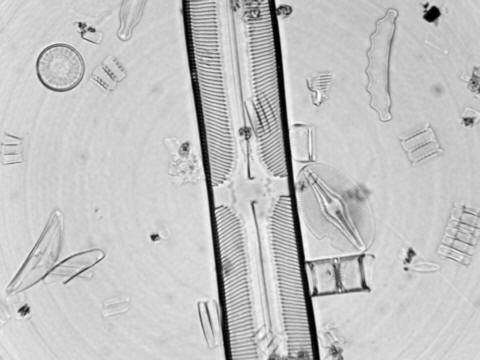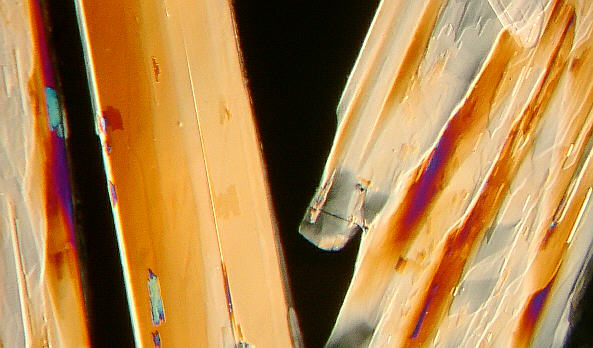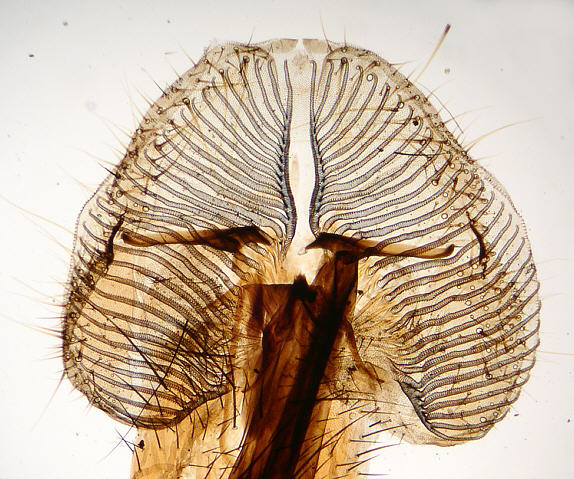 |
| Rings evident with COL illumination |
| An Imaging Problem With Digital
Cameras A short note to warn many potential buyers that some digicams are not suitable because of inherent imaging flaws. By Paul James (UK) |
The problem I am about to describe is not a common one I believe, but reports about its effects when using some of the Nikon Coolpix 900 series and the Coolpix 4500 have been noted on web sites. The image below is a typical example of the type, though some cameras might only display partial arcs rather than complete shadow rings :-
 |
| Rings evident with COL illumination |
The problem has been described under the vague term of 'Newton's Rings' but this is a well understood phenomenon relating to the coloured bands of light seen when two flat optical surfaces are in very close intimate contact and cause the well known visible interference patterns. The 'rings' seen in microscope imaging as shown above from cameras so afflicted, have nothing to do with this natural phenomenon.
The cause I believe is to do with another naturally induced manifestation based on the well understood Schlieren principles. Here the cause of the shadowing, whether they be rings or indeed of any shape, lies in the property of parallel light being deviating off axis and 'casting' the observed shadow effects. The rings are an exagerated 'silhouette view' of the very subtle differences in refractive index along the circular planes of the camera's optics. Whether it is the lens, balsam cements, or a filter plate I can't be certain. If the glass of the lens is causing this then the way it has been cast, could contribute to the disturbance of the ideal uniform refractive index of the glass material. The inference is that the lens elements have concentric zones of differing refractive indices, albeit minute discrepancies of such small proportions that imaging ordinary subjects fails to elicit their presence. The modern technique of 'spin casting' glass in moulds may be the principal cause of the ringing in the images, but as far as I am aware the problem has not been investigated thoroughly.
In general photography the effects are entirely absent, but when the emerging light from the eyepiece of highly coherent and virtually parallel ray bundles, passes through the camera's lens, they manifest themselves as circular shadows. The intensity and shape of these shadows probably varies from one afflicted camera to another so no one knows beforehand whether the effects are going to be subtle or more pronounced. The zoom setting appears to have an effect on the ring intensity on the F300. Some reports indicate that the Nikon Coolpix 900 series elicit variable 'ring' intensities with differing zoom setting also.
Does it affect all images in all illumination setups ?
In low power brightfield and darkfield and polarising work the effects are usually, but not always absent, and therefore rarely intrude. The critical setups are found to be phase contrast and COL and occasionally traditional oblique lighting.
|
|
Greyscaled phase contrast showing variation of rings with change in zoom setting. |
 |
No rings above in 'polar' medium power image crop. |
 |
Normal image in BF of fly's proboscis and no rings. |
Conclusion
Unfortunately there is no way of determining whether the camera you propose to buy has this inherent flaw, without of course trying it over the eyepiece. If you can however try to capture an image before parting with your money, so much the better, but this is difficult if not impossible in actual practice. Try to explain the situation to the camera dealer and see if he will send or lend you the camera on approval pending the outcome of your experiments.
It is a fact however that my Minolta F300 is flawed in its attempts to record microscope images, and that other F300's are likely to be too. In ordinary photographic use the F300 is extremely good, and I would not wish to blemish Minolta's otherwise splendid reputation as a quality digital camera manufacturer.
If you are only going to use brightfield and darkfield illumination, or 'polar' work then your chances of coming across this pnenomenon is greatly reduced, and so hopefully your choice of digicam remains unlimited.
| All comments welcome to the author Paul James |
Related
links:
Editor's note. Two online reports of studies of the ring artefact
in the Coolpix range are:
Klaus
Henkel's report in pdf format
'Artefacts
in photomicrographs'.
Gordon
Couger's and Brian Olson's web article
'990
995 Coolpix shootout' on Gordon Couger's
website.
Microscopy
UK Front Page
Micscape
Magazine
Article
Library
Please report any Web problems or offer general comments to the Micscape Editor.
Micscape is the on-line monthly magazine of the Microscopy
UK web
site at Microscopy-UK